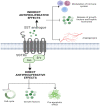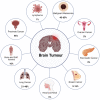Somatostatin and Somatostatin Receptors in Tumour Biology
- PMID: 38203605
- PMCID: PMC10779198
- DOI: 10.3390/ijms25010436
Somatostatin and Somatostatin Receptors in Tumour Biology
Abstract
Somatostatin (SST), a growth hormone inhibitory peptide, is expressed in endocrine and non-endocrine tissues, immune cells and the central nervous system (CNS). Post-release from secretory or immune cells, the first most appreciated role that SST exhibits is the antiproliferative effect in target tissue that served as a potential therapeutic intervention in various tumours of different origins. The SST-mediated in vivo and/or in vitro antiproliferative effect in the tumour is considered direct via activation of five different somatostatin receptor subtypes (SSTR1-5), which are well expressed in most tumours and often more than one receptor in a single cell. Second, the indirect effect is associated with the regulation of growth factors. SSTR subtypes are crucial in tumour diagnosis and prognosis. In this review, with the recent development of new SST analogues and receptor-specific agonists with emerging functional consequences of signaling pathways are promising therapeutic avenues in tumours of different origins that are discussed.
Keywords: Somatostatin: somatostatin receptors; signaling; tumours.
Conflict of interest statement
The author declare that he has no conflict of interest with the contents of this article.
Figures






Similar articles
-
Somatostatin receptor biology in neuroendocrine and pituitary tumours: part 1--molecular pathways.J Cell Mol Med. 2010 Nov;14(11):2570-84. doi: 10.1111/j.1582-4934.2010.01125.x. J Cell Mol Med. 2010. PMID: 20629989 Free PMC article. Review.
-
Somatostatin analogs and radiopeptides in cancer therapy.Biopolymers. 2002;66(3):161-83. doi: 10.1002/bip.10256. Biopolymers. 2002. PMID: 12385036 Review.
-
[The somatostatin receptor family--a window against new diagnosis and therapy of cancer].Tidsskr Nor Laegeforen. 2002 Feb 20;122(5):487-91. Tidsskr Nor Laegeforen. 2002. PMID: 11961977 Review. Norwegian.
-
Somatostatin and its receptor family.Front Neuroendocrinol. 1999 Jul;20(3):157-98. doi: 10.1006/frne.1999.0183. Front Neuroendocrinol. 1999. PMID: 10433861 Review.
-
The clinical use of somatostatin analogues in the treatment of cancer.Baillieres Clin Endocrinol Metab. 1990 Mar;4(1):29-49. doi: 10.1016/s0950-351x(05)80314-3. Baillieres Clin Endocrinol Metab. 1990. PMID: 1975166 Review.
Cited by
-
Screening and identification of potential target of 1'-acetoxychavicol acetate (ACA) in acquired lapatinib-resistant breast cancer.Heliyon. 2024 Nov 30;10(23):e40769. doi: 10.1016/j.heliyon.2024.e40769. eCollection 2024 Dec 15. Heliyon. 2024. PMID: 39698092 Free PMC article.
-
Agonists, Antagonists and Receptors of Somatostatin: Pathophysiological and Therapeutical Implications in Neoplasias.Curr Issues Mol Biol. 2024 Sep 2;46(9):9721-9759. doi: 10.3390/cimb46090578. Curr Issues Mol Biol. 2024. PMID: 39329930 Free PMC article. Review.
-
Differentially Expressed Somatostatin (SST) and Its Receptors (SST1-5) in Sporadic Colorectal Cancer and Normal Colorectal Mucosa.Cancers (Basel). 2024 Oct 24;16(21):3584. doi: 10.3390/cancers16213584. Cancers (Basel). 2024. PMID: 39518025 Free PMC article.
-
Comparison of radiolabeled somatostatin analogs (DOTATATE, DOTANOC, and DOTATOC) in somatostatin receptor (SSTR) imaging for gastroenteropancreatic neuroendocrine neoplasms (GEP-NENs): a narrative literature review.Ann Nucl Med. 2025 Aug;39(8):755-773. doi: 10.1007/s12149-025-02072-1. Epub 2025 Jun 28. Ann Nucl Med. 2025. PMID: 40580373 Review.
-
Somatostatin-immunoreactive neurons of the rat gut during the development.Histochem Cell Biol. 2024 Nov;162(5):385-402. doi: 10.1007/s00418-024-02322-9. Epub 2024 Aug 17. Histochem Cell Biol. 2024. PMID: 39153131
References
-
- Lane H.A., Beuvink I., Motoyama A.B., Daly J.M., Neve R.M., Hynes N.E. ErbB2 potentiates breast tumor proliferation through modulation of p27(Kip1)-Cdk2 complex formation: Receptor overexpression does not determine growth dependency. Mol. Cell Biol. 2000;20:3210–3223. doi: 10.1128/MCB.20.9.3210-3223.2000. - DOI - PMC - PubMed
Publication types
MeSH terms
Substances
Grants and funding
LinkOut - more resources
Full Text Sources
Medical

